When I tell people that I brine my turkey before cooking it on Thanksgiving (or any other time of the year) they first ask me why I do it and then ask if it's hard. A brined turkey retains its moisture so much better than a non-brined bird. The brine also imparts some extra flavor . I've also found that it cooks faster. Is it hard? No, it's not!
So, here's a short tutorial on how to brine a turkey. The recipe is at the bottom of this page and can also be downloaded as a PDF right here.
Start with a 12-16 pound turkey. It can be a little larger but you'll need to alter the cooking technique a bit if it's too much larger. If you've got a frozen turkey, thaw it in the refrigerator for 4 days or so. NOTE: You should try to find one that is not "basted," "self-basting" or "pre-brined." These birds are injected with a brine that will just make the turkey absorb less of your carefully prepared brine. Plus you're paying for a bunch of liquid that you don't want/need.
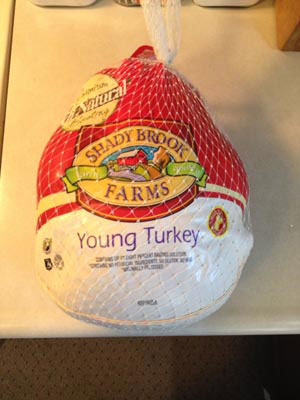
The brine consists of only a few ingredients. Most you probably already have in your kitchen... water, kosher salt, sugar, bay leaves, thyme, garlic, allspice berries & juniper berries.
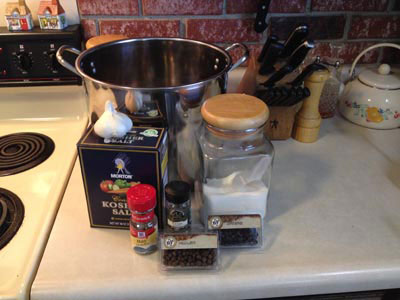
Start with the water in a large pot or other container.
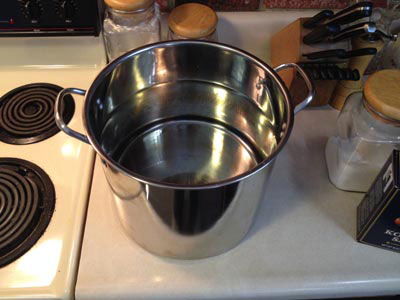
Add the kosher salt.

Gather remaining ingredients.
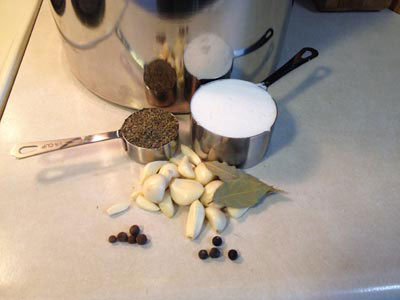
Tear the bay leaves into pieces.
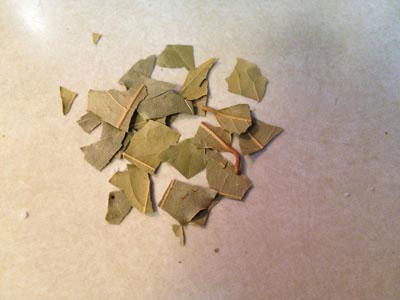
Coarsely smash the allspice berries and juniper berries before adding them. I prefer to use my mortar and pestle, but you could give them a smack with the side of your knife on a cutting board.

Add the remaining ingredients to the pot and stir until the sugar and salt have dissolved. You now have your brine.
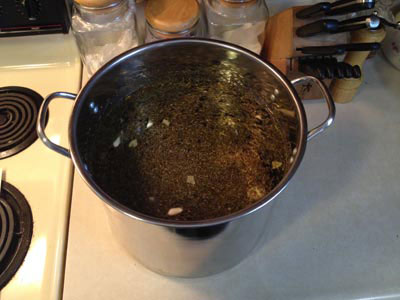
Line a clean 5-gallon bucket (you can pick one up at your local home improvement store) with a turkey brining bag or a Ziploc XXL bag.
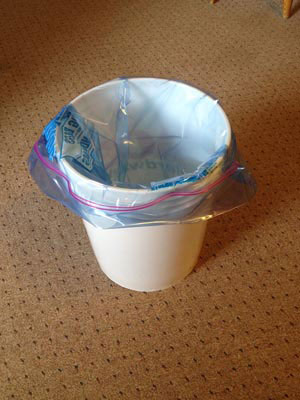
Unwrap your turkey and remove the organs that are likely packaged inside. (Save these for other uses or discard.) Yes, this particular turkey came with a chunk of breast skin missing.
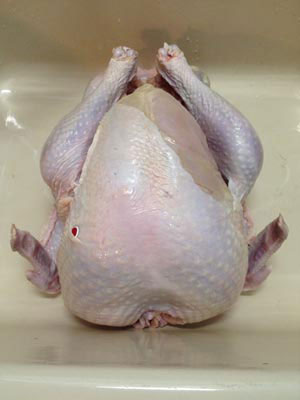
Place the turkey in the bucket.
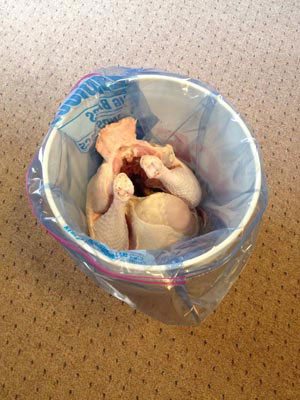
Carefully pour the brine into the bucket with the turkey.
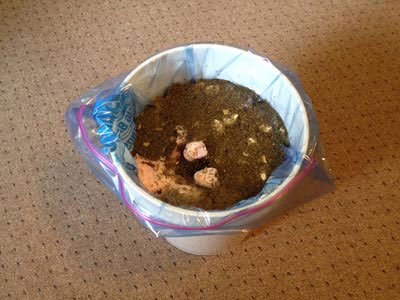
Seal the bag, squeezing all air out of it in the process. (I use a straw to suck out the last little bit.)
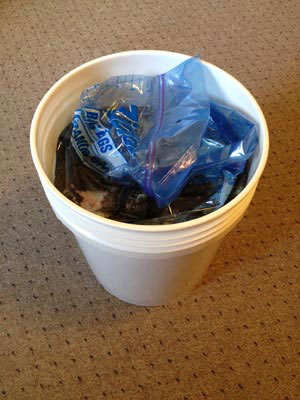
Place the bucket in a refrigerator overnight. You might need to remove some shelving. A refrigerator with a split shelf like mine is handy. Alternately, if you live someplace cold enough, you could put it in your garage, shed, etc.
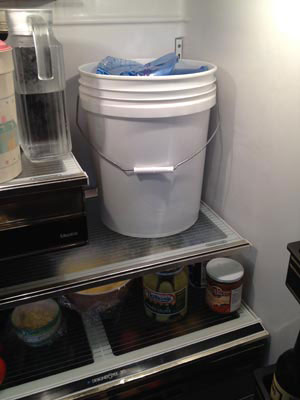
When it's time to cook the turkey, remove it from the brine, rinse it thoroughly and pat dry. Also, coarsely cut up the onion and celery.
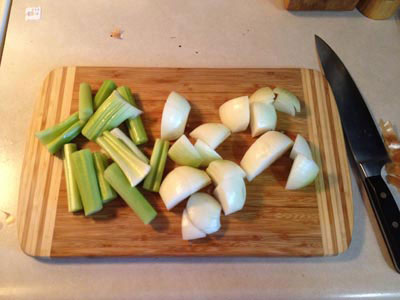
Place the turkey in a roasting pan with a v-shaped rack. Stuff the onion and carrot into the cavity of the bird with some salt and pepper. Tuck the wings under it as if it were laying back relaxing and truss the legs together with butcher’s twine.
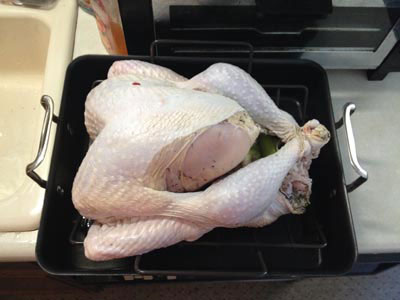
Rub the skin with softened butter. A pair of food-safe disposable rubber or plastic gloves will be a huge help with this task. Washing butter from your hands is more hassle than you need on Thanksgiving. Then salt and pepper the skin.
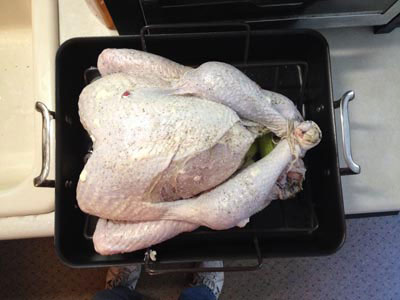
Tent the breast with foil. This prevents the breast from burning. The foil gets removed after one hour and you’ll need to baste the turkey with pan drippings and stock every 20 mins or so once the foil is off. NOTE: You will not be paying attention to the pop-up doneness indicator that is probably stuck in the breast of your turkey, but do not remove it because you will leave a hole through which juices can escape.
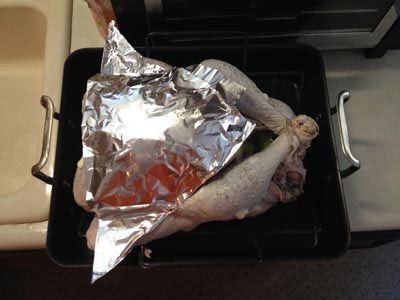
Roast at 400 degrees until the the thigh temperature is 165 degrees (about 1 3/4 to 2 1/4 hours). Your roasted turkey should hopefully look something like this. I'll just assume you know how to carve it. Perhaps that will be a future tutorial. NOTE: You probably won't want to use the drippings to make gravy because they could be salty.
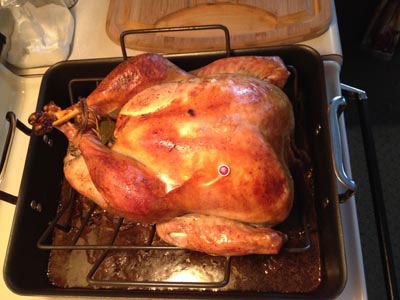
If you're going to have turkey, you need to have stuffing. Actually, I suppose it should rightfully be called dressing since it's not going in the bird, but instead being baked in a casserole dish. This allows both the turkey and stuffing to cook properly, while removing the risk of killing or sickening your family and guests by not heating the stuffing to a safe temperature.
This recipe started with my grandmother's recipe (which could be used to patch concrete). I made some drastic changes to make it a more traditional stuffing recipe while still retaining the same basic flavor profile. Download the recipe here or read it below the brine recipe that follows.
BRINED TURKEY
1 turkey, 12-16 lb
2 tbsp butter, softened
black pepper, ground, to taste
kosher salt, to taste
1 ½ cups turkey stock (or more)
BRINE
2 ½ gallon cold water
2 cups kosher salt
1 cup sugar
2 bay leaves, torn into pieces
¼ cup thyme, dried, or 1 bunch fresh
1 bulb garlic, cloves separated and peeled
5 whole allspice berries, crushed 4 juniper berries, smashed
Place the water in a large nonreactive pot. Add all the ingredients and stir for a minute or two until the sugar and salt dissolve.
Put the turkey into a large bucket or nonreactive pot (lining the bucket with a brining bag or XXL zipper bag will make clean-up easier and decrease the amount of brine needed) and refrigerate for 24 hours. If the turkey floats to the top, weight it down with a plate and cans to keep it completely submerged in the brine. You may halve or double the recipe. The important thing is to prepare enough brine to cover the turkey completely.
To roast: Preheat oven to 400 degrees. Remove the bird from the brine, rinse and drain well. Pat dry. Rub the skin with softened butter. Sprinkle with kosher salt and ground black pepper over the skin and in the cavity. Tuck the wing tips under, truss the legs and place the turkey on a v- shaped rack in a roasting pan. Tent the breast with foil and place the turkey in the oven.
After about 1 hour, remove the foil and baste the turkey with 1/2 cup stock. Re-baste it with pan drippings and more stock, every 20 minutes.
Roast the turkey until the internal thigh temperature reaches 165 degrees, approx. 1 3/4-2 1/4 hours.
For a Big Bird:
Preheat the oven to 350 degrees. Prepare a 20- to 22- pound turkey as directed, but double the amount of softened butter, salt and pepper.
Roast and baste (using about 1 cup of stock) according to the above directions. Cover the legs with foil if they begin to over brown. Roast until the internal thigh temperature registers 165 degrees, about 3 1/2 hours.
TURKEY STUFFING
12 cups white bread, cut into half inch cubes (about a 1 lb. loaf)
3/4 cup butter
1/2 cup onion, chopped
2 cups celery, chopped (about 4 or 5 stalks)
1 teasp sage
1/2 teasp thyme
1 teasp salt
1/2 teasp pepper
3 eggs, beaten
1 1/2 to 2 cups turkey broth, or stock
Slice bread into 1/2 inch thick slices if it is not pre-sliced. Cut the slices into 1/2 inch cubes. Spread the cubes out on baking sheets and allow to set out overnight to dry or bake in an oven at 275°F for approximately 20 minutes or until cubes are dry. Stir the bread cubes occasionally while drying so they dry evenly. Be sure bread is fairly dry before using. Do not use moist bread because it will result in soggy stuffing.
Preheat oven to 350.
Chop the onion into small pieces and set aside.
Chop celery into approximately 1/4 inch pieces.
Melt butter in a skillet over medium heat. Add the onions and celery to the melted butter and cook until onions begin to soften and turn a light golden brown. The celery should still be slightly crunchy.
Remove the onions and celery from the heat and add the sage, thyme, salt and pepper.
Place the bread cubes in a bowl large enough to mix all the ingredients together. Add the onion and celery mixture to the bread cubes and stir until the ingredients are well mixed.
Begin adding the broth or stock gradually. Only add enough liquid to moisten the stuffing enough for it to hold together. Begin by adding 1 cup or less.
When adding liquid, remember that the eggs still need to be added, which will add a little moisture also.
Add more seasoning if necessary. Add the beaten eggs and stir until they are well distributed. If necessary, add more liquid.
Butter the sides and bottom of a baking dish large enough to hold the dressing.
Pour dressing into the baking dish and pat lightly. Pour 1/2 to 1 cup of additional liquid over the dressing.
Cover the dressing with foil and seal tightly around all edges. Bake for 30 to 45 minutes, depending on the quantity, until dressing is nicely browned and internal temperature is 165°F. Remove the foil from the dressing during the last 15 to 20 minutes of cooking time to allow the dressing to brown.
